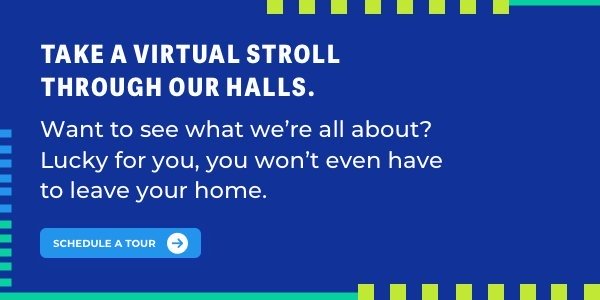Filling Public School Gaps: When to Consider Virtual Charter Schools
Whether parents realize it or not, traditional public schools are failing. And the gaps in learning are widening at a scary pace. Luckily, if you spot learning gaps early on, you can avoid long-term learning consequences for your child.
Suspicious that your public school isn’t meeting your student’s needs? We’ve identified some easy ways to know for sure. In this article, we explore the common gaps in traditional public schools and the telltale signs that it’s time to move your learner to a virtual charter school.
Where Are the Gaps in Traditional Public Schools?
According to the Nation’s Report Card, an assessment put out by the National Assessment of Educational Progress, traditional public schools are failing to break through across subjects and grade levels. Here are some alarming learning deficiencies the most recent report found:
- Only 24 percent of high school seniors are proficient in math.
- Only 22 percent of seniors are proficient in science.
- Only 27 percent of eight-graders are proficient in writing.
- Only 35 percent of fourth-graders are proficient in reading.
What’s causing this chasm in learning? Of course, there are a range of reasons traditional public schools are faltering, but here are some common reasons they’re set up to fail:
1. Progress is difficult.
Many public schools answer to massive school boards. So it is no surprise that these juggernauts are difficult to move when it comes time to change. Often, even if schools identify learning solutions on a local level, real progress is hindered by red tape.
2. Classrooms are packed.
It is no secret that traditional public schools are packed across the nation. Unfortunately, crowded classrooms can wreck a student’s education. They leave instructors with the unachievable task of finding time to connect with every student while also thoroughly teaching their lessons. In turn, students end up receiving a watered-down education and miss out on the attention they need to grow.
3. Schedules are stiff.
Most parents today grew up learning within the confines of a traditional bell schedule. However, today’s students have different pressures and can benefit from a more flexible learning environment. The rigidity of a traditional school day is a problem that touches the lives of all students, but there are a few student groups that are especially hindered by set bell schedules:
- Student athletes: Student athletes have to juggle schoolwork with everything from practice and training to games and tournaments. Without the ability to learn on the go or build their own schedules, student athletes often end up adding extra pressure to their day.
- Homeschoolers: Homeschoolers are comfortable learning in a flexible environment. It can be a big shock if they are asked to adjust to learning on a strict schedule in a far-off classroom.
- Performing artists: To reach their full potential, performing artists need to practice, hone their skills, and travel to events. Having to find time to develop their art in addition to a long school day—not to mention homework—can heap extra responsibilities on both them and you.
How to Know if Traditional Public Schools Are Failing Your Child
If your student is struggling or you have a feeling traditional public school just isn’t right, it is important to pick up on the signs early. Here are some red flags that indicate your child may be better off at a virtual charter:
1. They’re not getting personalized attention.
Make no mistake: If your school isn’t delivering personalized attention, your child’s education is suffering. Studies find that schools that offer personalized learning see higher student performance on average. If your student feels neglected or isn’t able to move at their own pace, it may be time to look into a virtual charter school that features personalized learning.
2. They’re not engaged.
Since the pandemic took hold, traditional public schools have rushed to offer online learning options. Unfortunately, this hurried approach has left instructors relying on traditional curricula that is not meant to reach students online.
The result?
Students end up bored or distracted. In turn, learning suffers. If your student isn’t actively stimulated by coursework and engaged, it means you should be looking for a virtual charter that has taken the time to develop engaging online coursework.
3. Their schedule is overwhelming.
If your child is racing around in the morning to catch the bus or up late balancing schoolwork and extracurriculars, they’re missing out. Rigid bell schedules force students to pack learning into a tight block of hours. If they have practice, training, performances, or events, those unyielding schedules can be overwhelming. If your student’s schedule is too much to handle, it is worth considering a more flexible learning environment.
4. They’re falling behind.
If your student is falling behind, they need a school that can connect with them on a deeper level and help them catch up. Sadly, traditional public schools rarely have the resources or structure to help students make up ground. A better option is to locate a virtual charter that includes personalized learning, small classes, and self-paced coursework.
5. They’re not reaching their full potential.
Even if your student is getting good grades, traditional public schools could be holding them back inside or outside the classroom. If inflexible classes are cutting into practice or training, your child could be missing opportunities as an athlete or performing artist. At the same time, high achievers are often left idling in traditional public classrooms, waiting for other classmates to catch up. In this instance, too, self-paced learning and flexible schedules could help them excel.
How Do Virtual Charter Schools Fill in Learning Gaps?
Wondering how virtual charter schools are bridging the learning gaps that plague traditional public schools? Here are a few tools that are taking learning to a new level:
1. Personalized Learning
The best virtual charter schools use technology, along with targeted direct instruction, to personalize learning to fit the student’s needs. These programs adjust to the learner to boost outcomes.
2. Self-Paced Coursework
Advanced online charters feature self-paced coursework. Self-pacing allows students to spend extra time on difficult subjects, advance faster, and catch up quickly.
3. Flexible Schedules
Some virtual charter schools provide flexible learning hours. That way, your student can craft a schedule to fit their learning style and responsibilities.
4. Digital Learning Experts
Students are used to digital environments and online education. After all, more than 4 billion people are active on the internet. Simply put, virtual charter schools give students the online environment they’re used to. More importantly, they’re run by distance learning experts who have deep experience leading online. That means your student doesn’t have to waste time teaching their instructors how to use the technology that’s supposed to be supporting their own learning.
How to Choose a Trustworthy Virtual Charter School
Unfortunately, not all virtual charter schools are set up to meet your student’s needs. Even though, in general, they’re set up with advantages over traditional public schools, it doesn’t mean all virtual charters offer a quality education. Here are a few steps to take if you want to identify a virtual charter school that will deliver learning results:
1. Take a close look at the curriculum.
Not all virtual charters will feature a curriculum you can trust to meet your student’s learning needs. In fact, the Department of Education warns against falling victim to online diploma mills that leave your student underprepared after graduation. There are a few ways to make sure curriculum is trustworthy:
- Coursework should be NCAA and UC A-G approved
- Curriculum should be engaging and interactive
- Classes should include self-paced learning that adjusts to each student’s needs
2. Pay attention to the school’s reputation.
Another way to know a virtual charter school is trustworthy is to dig into its reputation. Make sure the program is accredited by a major institution. Also, double-check to be sure classes are led by distance learning experts who have experience teaching students online.
3. Dig into instruction.
Especially when it comes to online learning, instruction needs to connect with students on a deep level. That’s why it is smart to find a virtual charter that makes small class sizes a priority. Instruction should be targeted and personalized. The school should also have programs in place to help students develop their social skills.
Fill in Learning Gaps with a Trusted Virtual Charter School
Are you looking for a virtual charter school to help your learner succeed? Method Schools has long been helping students learn, grow, and reach their goals—all within a trusted online learning community.
Want to discover more about Method Schools and learning with us? Talk with one of our distance learning experts today.




-1.svg)
.svg)
-1.svg)
.svg)
.svg)

.svg)










.svg)
.svg)






